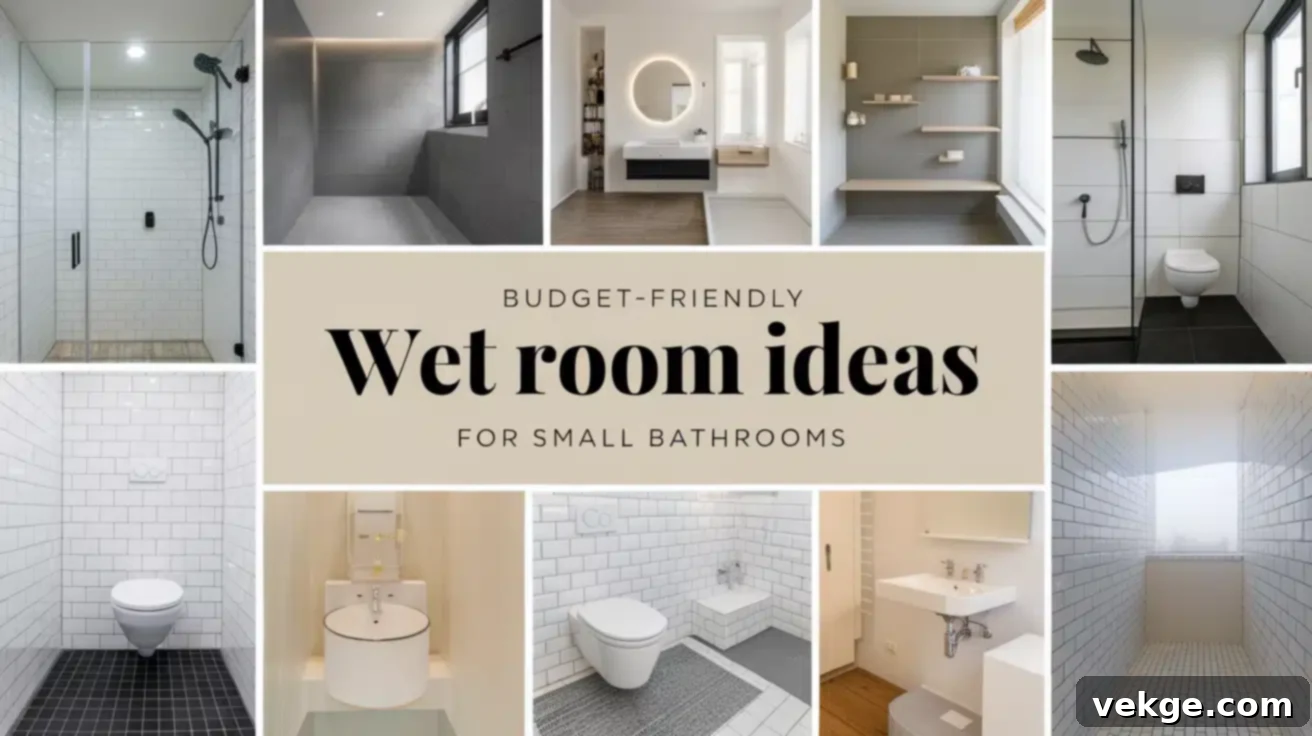Transform Your Small Bathroom: 21 Budget-Friendly Wet Room Ideas for Modern Living
Are you dreaming of a sleek, modern wet room but worried your small bathroom space or limited budget might hold you back? You’re in luck! This comprehensive guide provides 21 innovative and practical ideas to transform even the tiniest bathroom into a stylish and functional wet room, all while keeping costs manageable.
Many homeowners struggle with the challenge of maximizing space and achieving a contemporary look in compact bathrooms without overspending. I understand these concerns deeply. That’s why I’ve curated a list of affordable, real-life solutions designed to help you save money, optimize every inch, and give your bathroom a significant aesthetic upgrade. You don’t need to compromise on style or functionality when you’re on a budget.
A wet room is essentially a fully waterproofed bathroom where the shower area is completely open or separated by a minimal screen, doing away with bulky shower stalls or trays. This design offers several compelling advantages for small spaces:
- Space-Saving: The seamless flow makes small bathrooms feel significantly larger and more open.
- Easy to Maintain: Fewer nooks and crannies mean less scrubbing and quicker cleaning.
- Modern Aesthetic: They exude a contemporary, minimalist vibe that instantly updates your home.
- Enhanced Accessibility: With a level floor, wet rooms are ideal for all ages and mobility levels.
While often perceived as an expensive renovation, creating a chic and functional wet room doesn’t have to break the bank. This guide will walk you through a range of wallet-friendly steps and clever hacks. Let’s dive into these brilliant ideas and discover how to achieve your dream wet room without financial strain.
Budget-Friendly Wet Room Ideas for Small Bathrooms
1. Use Large Format Tiles for an Expansive Feel
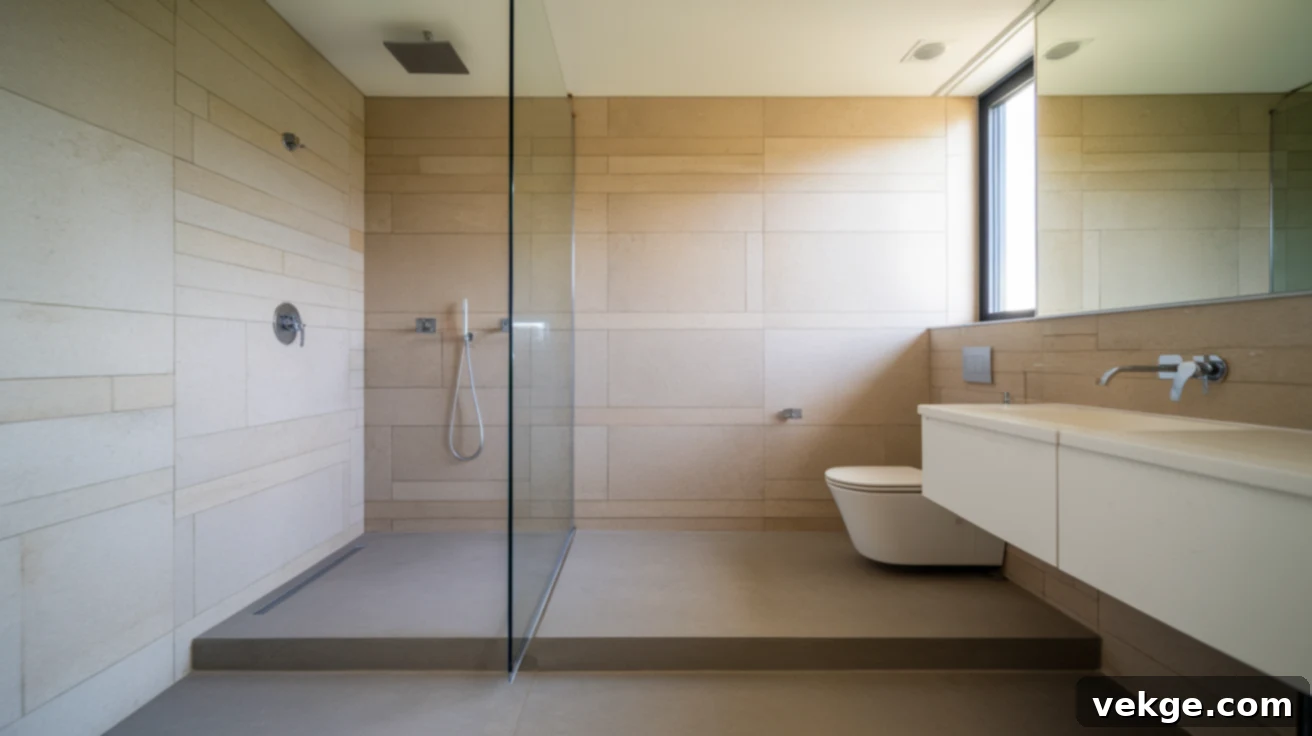
One of the most effective ways to make a small wet room appear larger and more luxurious is by using large format tiles. These tiles significantly reduce the number of grout lines on your walls and floor, creating a more seamless and uninterrupted visual flow. This expansive look tricks the eye into perceiving a bigger space, instantly elevating the room’s aesthetic.
Beyond their visual benefits, large tiles offer practical advantages. With fewer grout lines, there’s less surface area for dirt, soap scum, and mold to accumulate, making your wet room much easier to clean and maintain. To further enhance brightness and a modern appeal, consider opting for neutral shades such as whites, grays, or light beige. This choice not only contributes to a clean, contemporary look but can also help reduce overall material and labor costs, especially when compared to intricate mosaic tiling.
2. Go for a Simple and Frameless Shower Screen
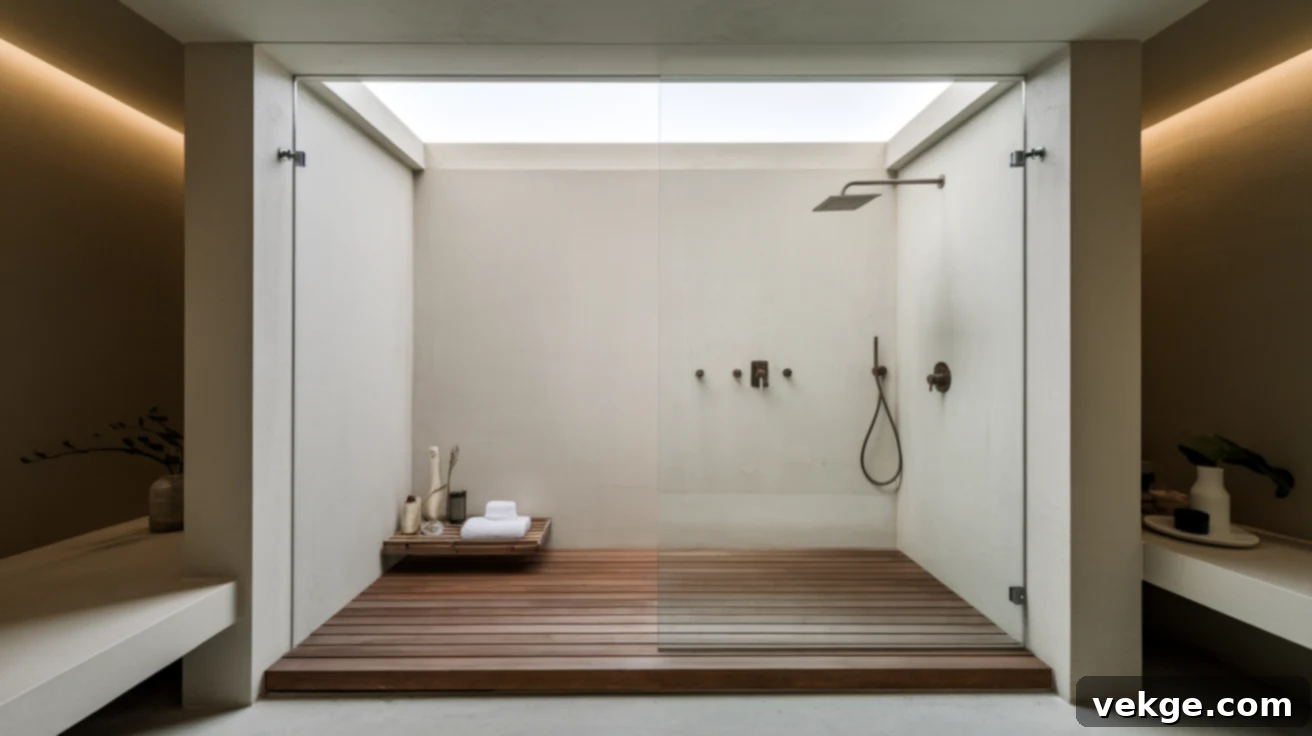
A clear or frameless shower screen is a brilliant design choice for small wet rooms. Unlike bulky, framed enclosures that can make a space feel cramped, a minimalist screen maintains an open, airy feel while effectively containing water splashes within the shower area. Its transparency allows light to flow freely, further contributing to the illusion of a larger room.
This space-saving solution is also highly cost-effective compared to full glass doors or custom-built enclosures. Installation is typically straightforward, often requiring minimal effort and thereby saving on labor costs. Choose a single pane of tempered glass for a sleek, unobtrusive look that blends seamlessly into the wet room’s design, enhancing both functionality and modern aesthetics.
3. Choose High-Quality Waterproof Paint
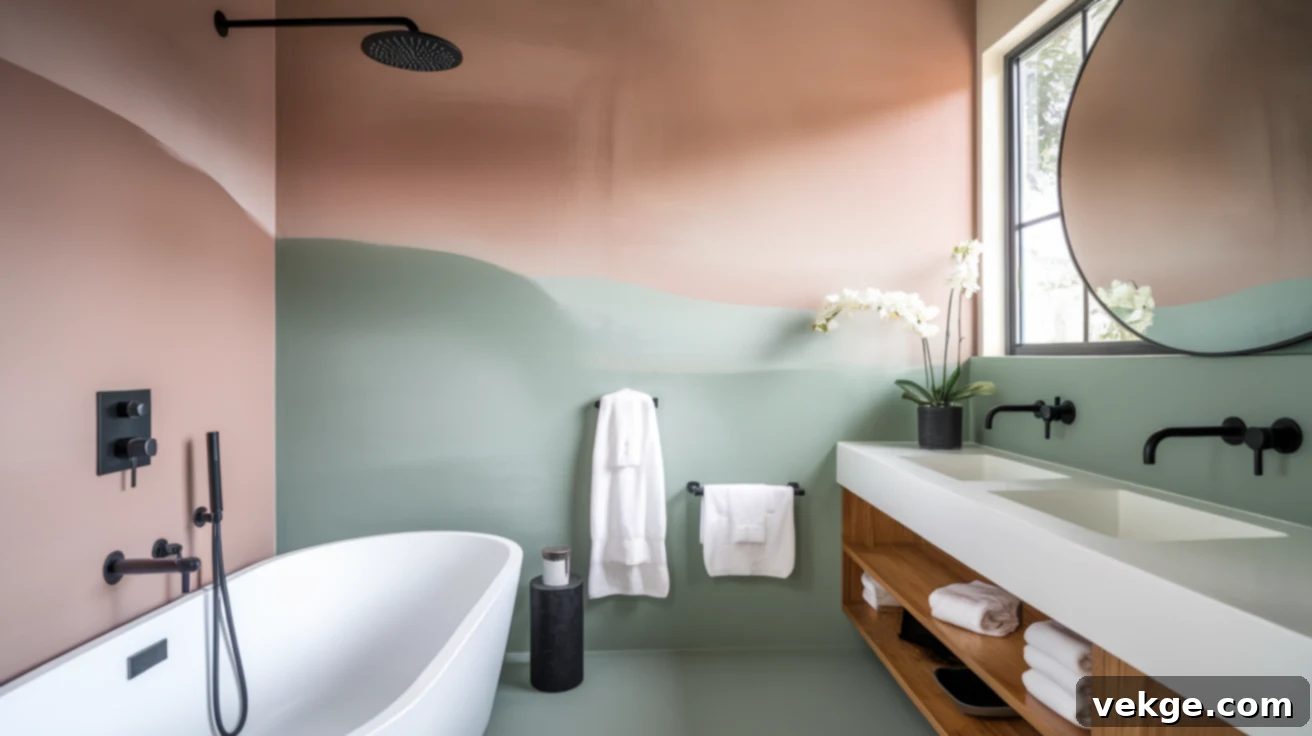
For a truly budget-friendly wet room transformation, consider using waterproof paint instead of extensive tiling for your walls. This option provides excellent protection against moisture damage and mold without the significant expense of purchasing and installing tiles. Modern waterproof paints are formulated to withstand high humidity and direct water contact, offering durability and longevity.
Available in a vast array of colors and finishes, waterproof paint allows for immense customization, helping you achieve your desired aesthetic at a fraction of the cost. A few coats of a high-quality, mold-resistant paint can provide a long-lasting, low-maintenance surface that keeps your wet room looking fresh, clean, and vibrant. It’s an ideal choice for adding personality while ensuring your walls are fully protected.
4. Opt for Durable Vinyl Flooring
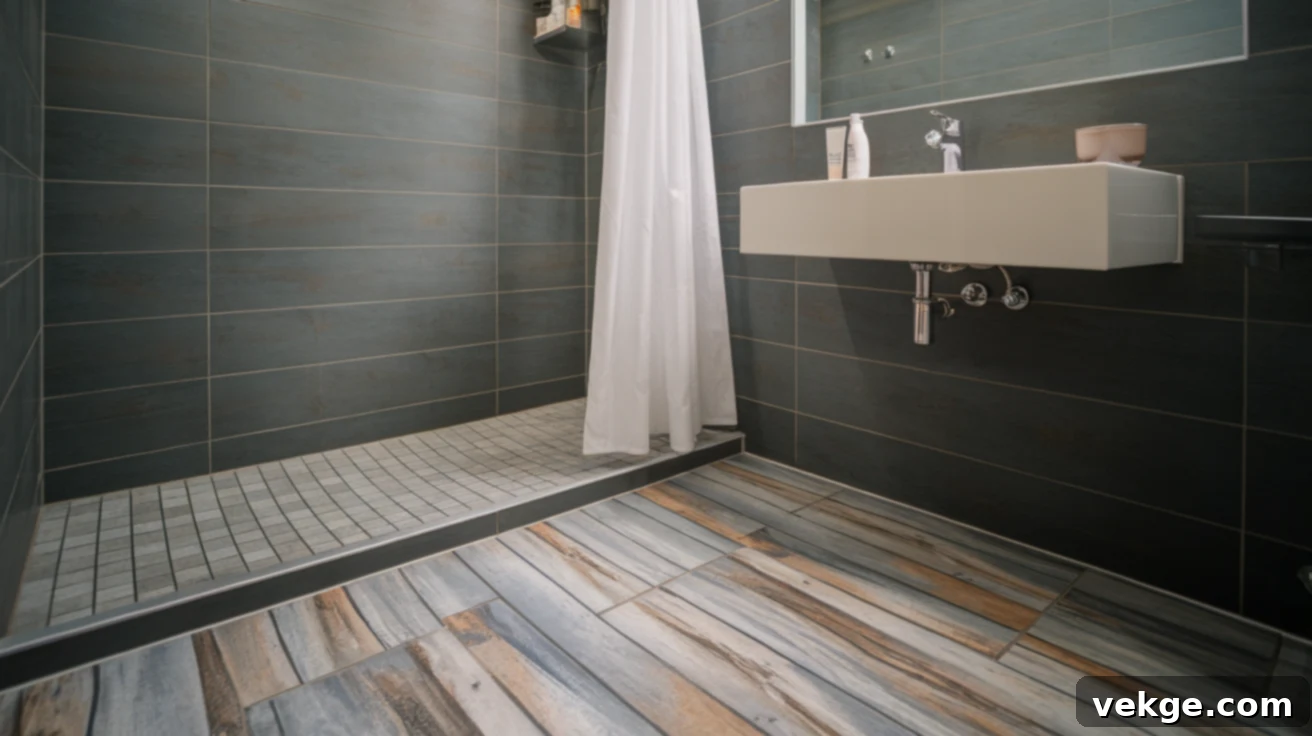
Vinyl flooring is an increasingly popular and highly practical choice for wet rooms, offering a waterproof, slip-resistant, and significantly more affordable alternative to traditional ceramic or porcelain tiles. Its versatility is remarkable, with options available in countless patterns and textures, including convincing imitations of wood, stone, or even concrete, allowing you to achieve a sophisticated look on a budget.
Installation is generally easier and quicker than tiling, which can lead to further savings on labor costs. Beyond its cost-effectiveness, vinyl provides a warmer surface underfoot than tiles, enhancing comfort, especially during colder months. It’s also incredibly low maintenance, requiring just a simple wipe to keep it looking pristine. This material is perfect for creating a stylish and functional wet room without compromising on safety or aesthetics.
5. Install a Seamless Walk-In Shower
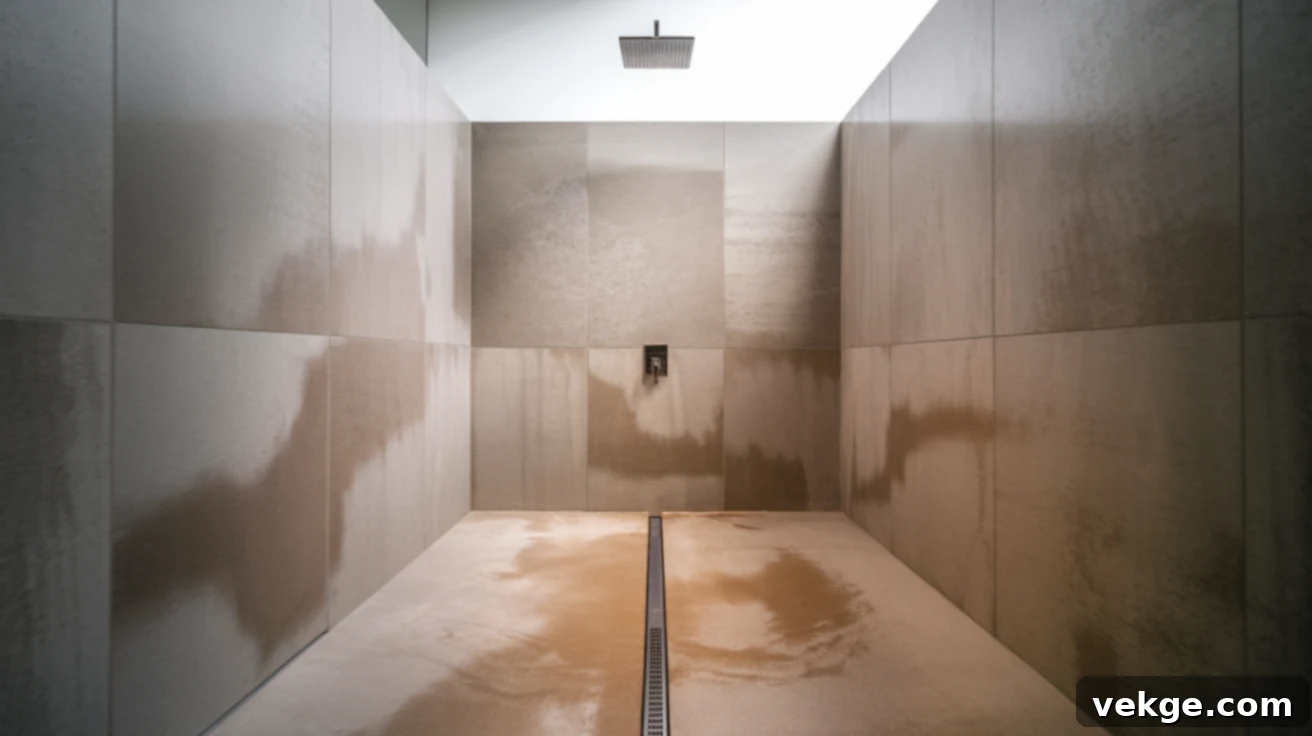
A walk-in shower is almost synonymous with wet room design, and for good reason. By eliminating the need for bulky shower trays or complex enclosures, it creates an uninterrupted flow across the bathroom floor, making the entire wet room feel significantly larger and more open. This design enhances both aesthetics and functionality, promoting a minimalist and contemporary vibe.
One of the key benefits is improved accessibility, making it ideal for everyone, including those with mobility challenges. The level floor, seamlessly integrated with the rest of the room, allows for efficient water drainage and simplifies cleaning, as there are fewer obstacles and crevices. Opting for a simple, floor-level walk-in shower can also reduce complex installation costs, providing a sleek, modern, and highly practical solution for any small wet room.
6. Utilize a Wall-Mounted Sink
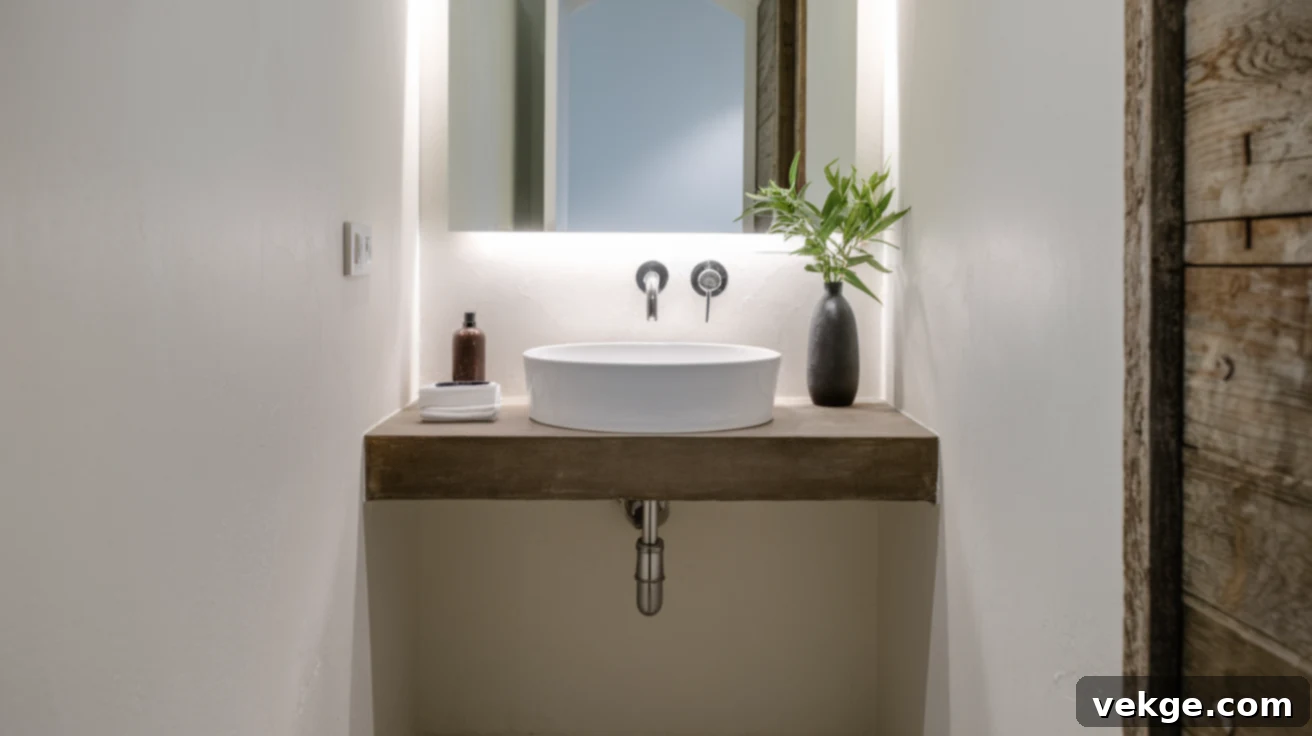
In a small wet room, every inch of floor space counts. A wall-mounted sink is an excellent choice for freeing up valuable floor area, which in turn creates a more open and streamlined look. By elevating the sink off the floor, it enhances the perception of space, making the room feel larger and less cluttered.
Beyond its space-saving benefits, a wall-mounted sink is considerably easier to clean underneath, promoting better hygiene and simplifying maintenance. These sinks are available in a variety of modern designs, from sleek minimalist bowls to more practical units with integrated towel bars. This fixture provides essential functionality while contributing to a contemporary aesthetic, making it a perfect fit for compact wet rooms aiming for a clean, unobtrusive design.
7. Add a Floating Toilet for Minimalism
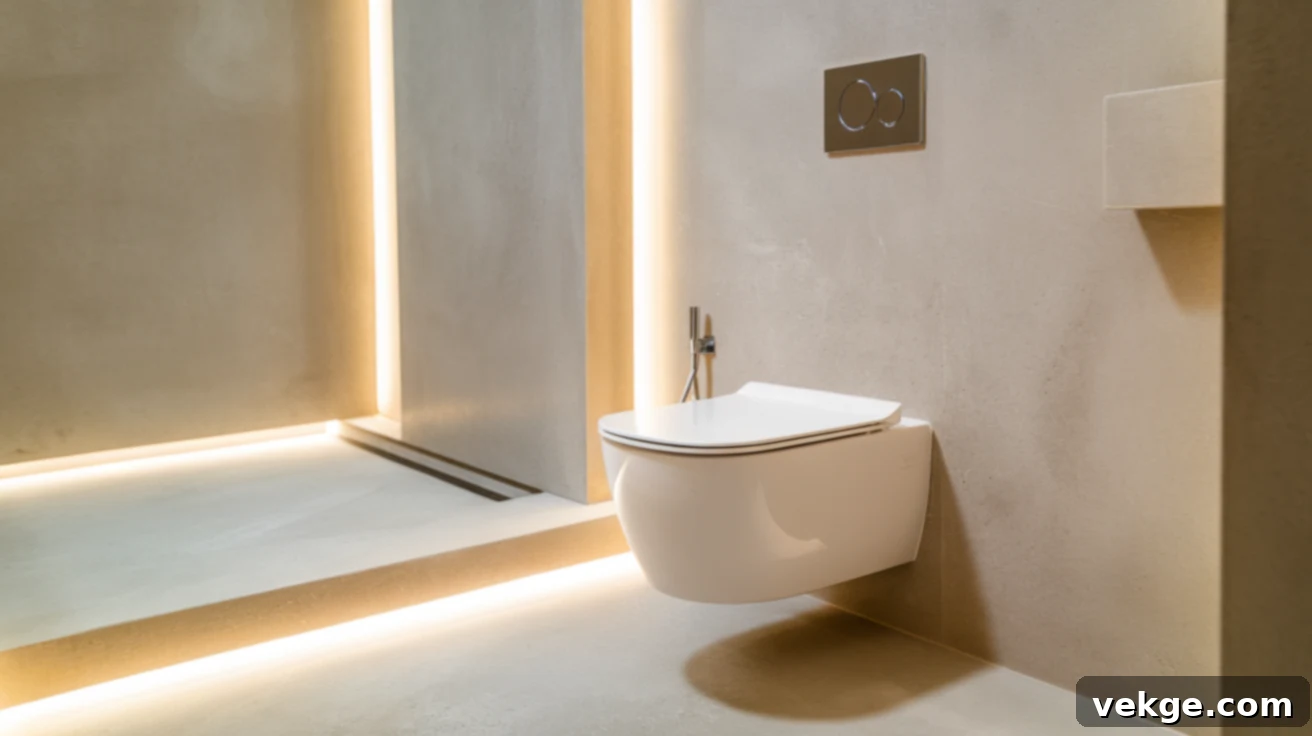
Similar to a wall-mounted sink, a floating toilet is an ingenious solution for maximizing space and enhancing the modern aesthetic of a small wet room. Mounted directly to the wall, this type of toilet leaves the floor beneath completely clear, contributing to an open, expansive feel and making cleaning significantly easier. No more awkward scrubbing around the base!
The cistern of a floating toilet is cleverly concealed within the wall, ensuring a sleek, minimalist design that maximizes available room and eliminates visual clutter. This integration helps create the illusion of a larger floor area, further enhancing the wet room’s overall contemporary appeal. It’s a smart, space-efficient choice that combines practicality with high-end design.
8. Keep Storage Minimal and Smart

In a compact wet room, excessive storage can quickly lead to a cluttered and overwhelmed feeling. The key is to keep storage minimal and utilize smart, space-efficient solutions. Instead of bulky cabinets, consider open shelves, wall-mounted racks, or built-in niches. These options provide necessary storage for essentials like toiletries, towels, and decorative items without encroaching on precious floor space.
By keeping only what you truly need within easy reach and opting for clever vertical storage, your wet room can remain organized, airy, and visually appealing. This approach ensures that the room maintains its open concept, preventing it from feeling cramped and maximizing the sense of spaciousness that wet rooms are designed to offer.
9. Install a Single Drain Slope for Efficiency

When designing the drainage for a small wet room, simplicity often translates to efficiency and cost savings. Instead of configuring multiple drains or complex slopes, opting for a single, well-planned drain slope channels water effectively to a central or linear drain. This design simplifies installation, reducing both labor time and material costs compared to more elaborate drainage systems.
A single, consistent slope ensures that water drains quickly and completely, preventing pooling and maintaining a dry floor outside the immediate shower area. This not only enhances safety by reducing slip hazards but also contributes to the sleek, seamless look characteristic of modern wet rooms. Moreover, a simplified drainage system is generally easier to clean and maintain, helping to prevent clogs and ensure long-term functionality.
10. Use Light Colors to Amplify Space
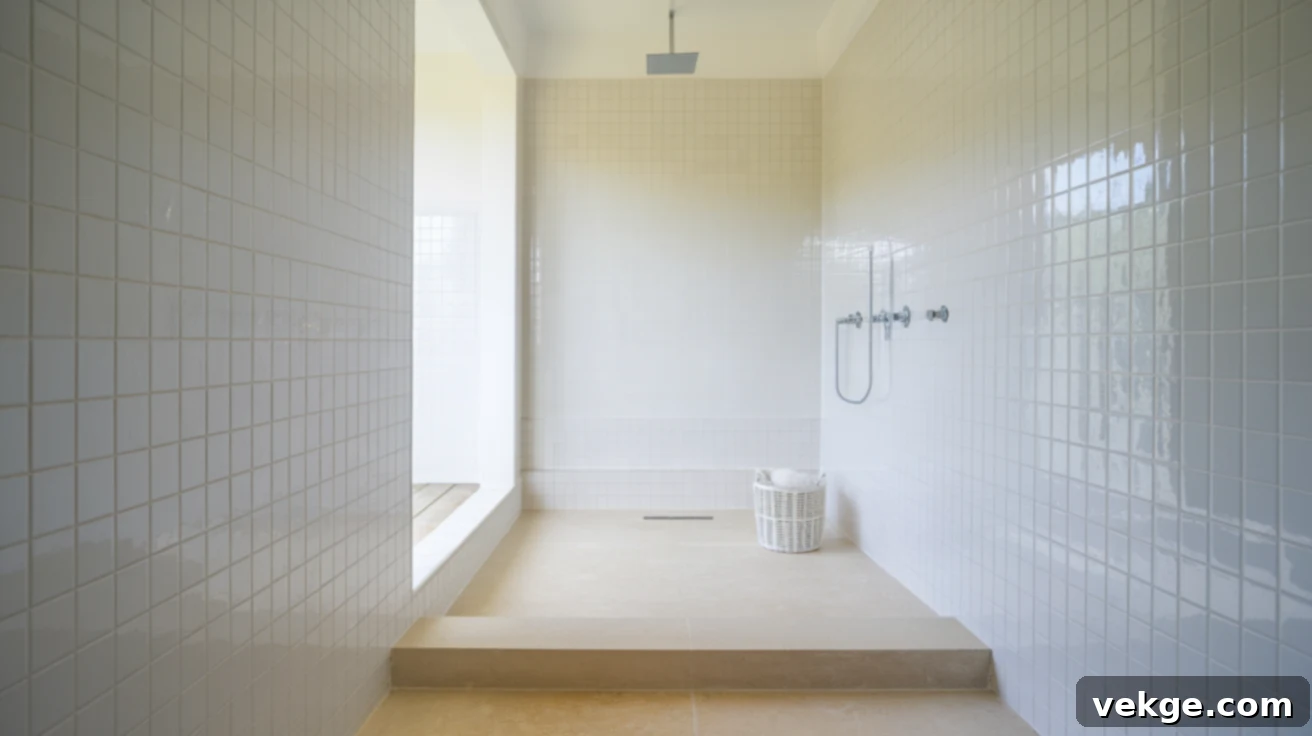
The power of color in interior design, especially in small spaces, cannot be overstated. Utilizing light colors throughout your wet room is a classic and highly effective technique to make the space feel significantly bigger and brighter. Shades of white, cream, beige, pale grays, and soft pastels reflect both natural and artificial light, creating an open, airy, and inviting atmosphere.
By applying lighter shades to walls, floors, and even ceilings, you create a cohesive and expansive canvas that minimizes visual breaks and maximizes perceived space. Beyond the illusion of grandeur, light colors also enhance the sense of cleanliness and purity, which is particularly desirable in a wet room environment. This simple yet impactful design choice requires no major renovations but delivers a dramatic visual improvement.
11. Incorporate Mirrors for Depth and Light
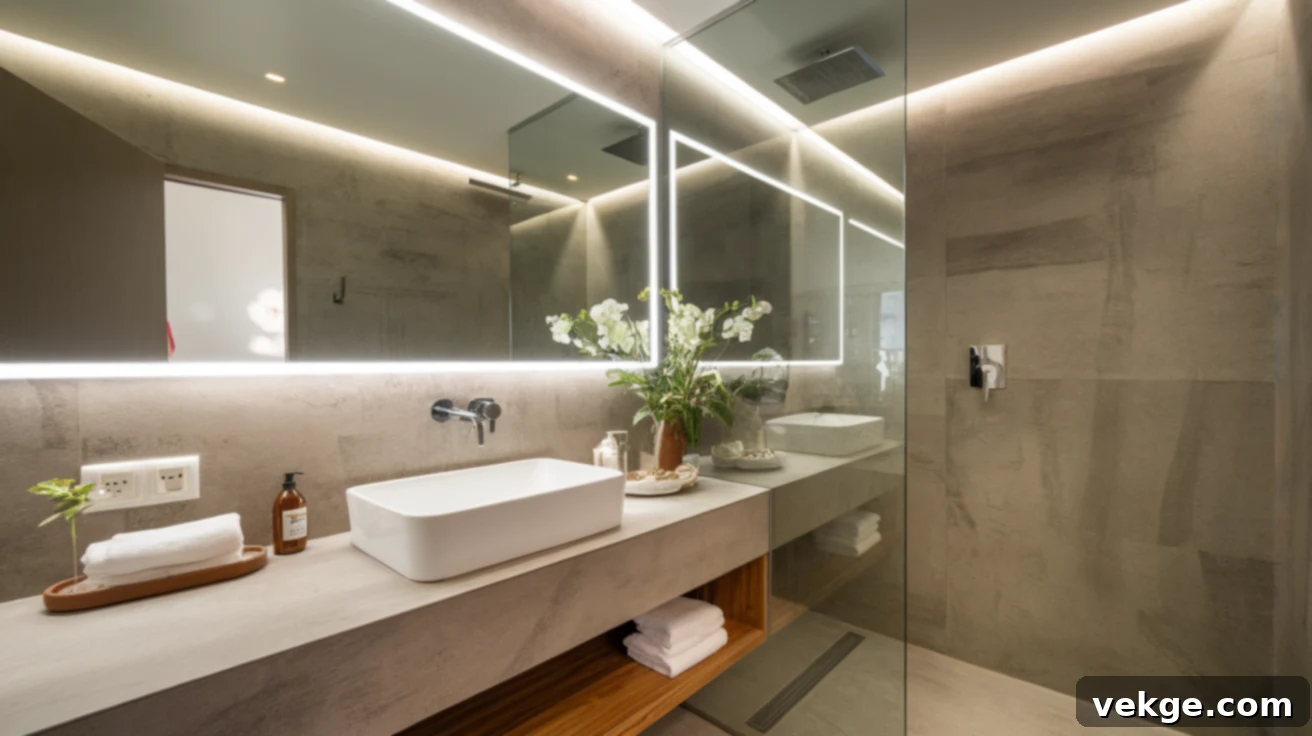
Mirrors are a designer’s secret weapon for creating the illusion of a larger, more open space, and they are particularly effective in small wet rooms. By strategically placing a large mirror or incorporating mirrored cabinet doors, you can reflect light and expand the perceived dimensions of the room. This not only makes the wet room feel more spacious but also significantly enhances its brightness.
Positioning a mirror opposite a window or a light source can maximize natural light, bouncing it around the room and brightening darker corners. Beyond their functional ability to create depth, mirrors also add a touch of elegance and sophistication, acting as a stylish design element without taking up physical space. It’s a cost-effective way to achieve a grander aesthetic in a compact area.
12. Go for a Space-Saving Pocket Door
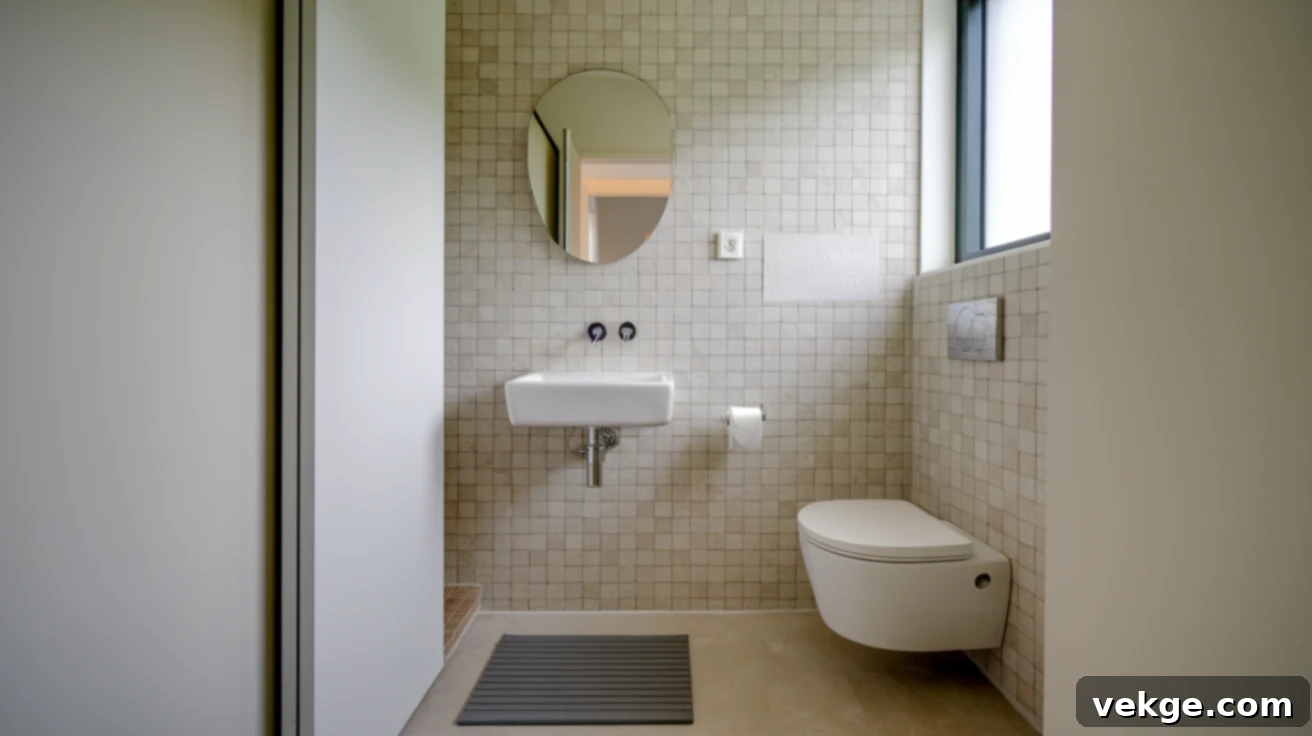
Traditional swing doors require a significant amount of clearance space, which can be a luxury in a small wet room. A pocket door offers an elegant and highly practical solution by sliding directly into a recess within the wall. This innovative design completely eliminates the need for floor space around the doorway, dramatically improving flow and accessibility within the compact layout.
Installing a pocket door allows you to make better use of the wall space that would otherwise be occupied by a swinging door, enabling more flexible placement of fixtures, towel rails, or shelving. It also lends a clean, contemporary look to your wet room, contributing to a seamless and uncluttered aesthetic. While it might involve a bit more installation complexity, the long-term benefits of maximized usable space are invaluable.
13. Choose Budget-Friendly Waterproof Wall Panels
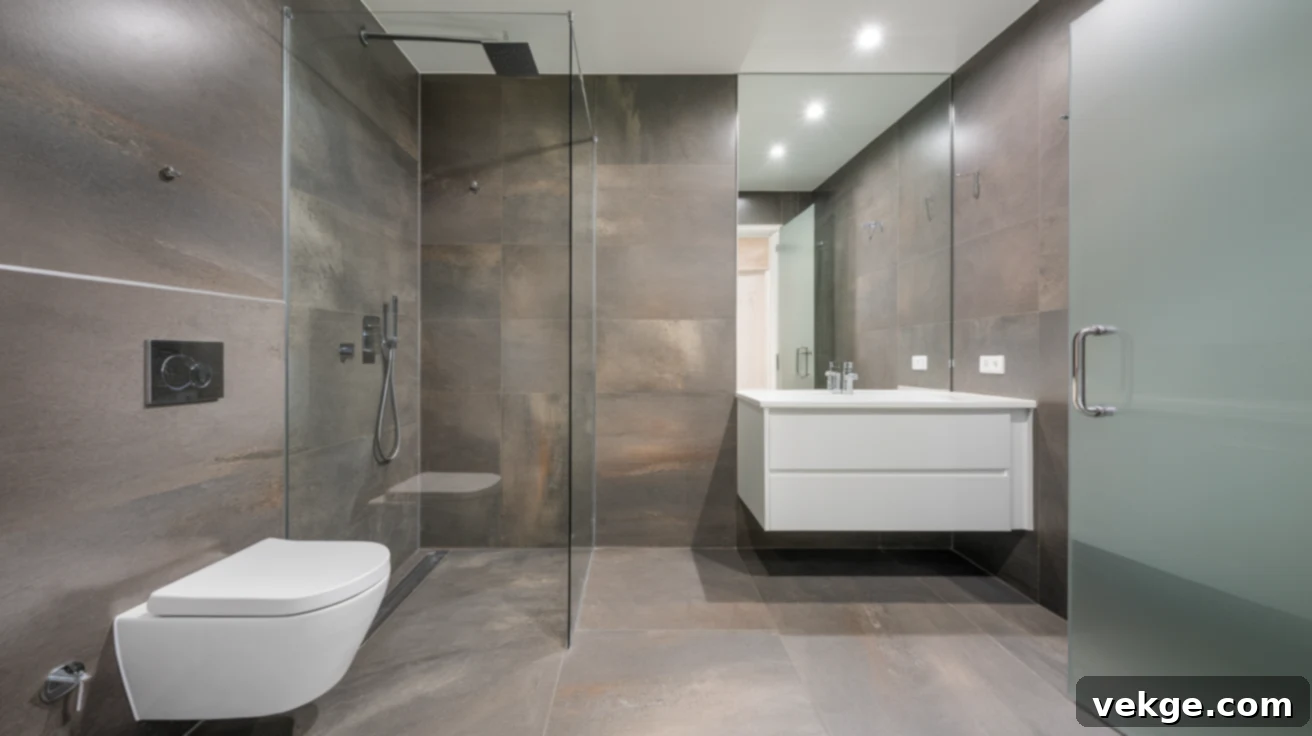
For an excellent, cost-effective alternative to traditional tiling, consider waterproof wall panels. These panels offer superior waterproofing and are typically much faster and easier to install than tiles, saving both on material and labor costs. They are designed to be highly resistant to mold and mildew, making them a hygienic and low-maintenance option for any wet room.
Wall panels come in an impressive variety of textures, colors, and finishes, including options that mimic natural stone, wood, or smooth concrete, allowing you to achieve a sophisticated look without the premium price tag. Unlike grout lines which can stain and harbor grime, wall panels provide a continuous, easy-to-clean surface. This makes them an ideal solution for budget-conscious renovations seeking durability, style, and minimal upkeep.
14. Use a Ceiling-Mounted Showerhead for a Minimalist Look
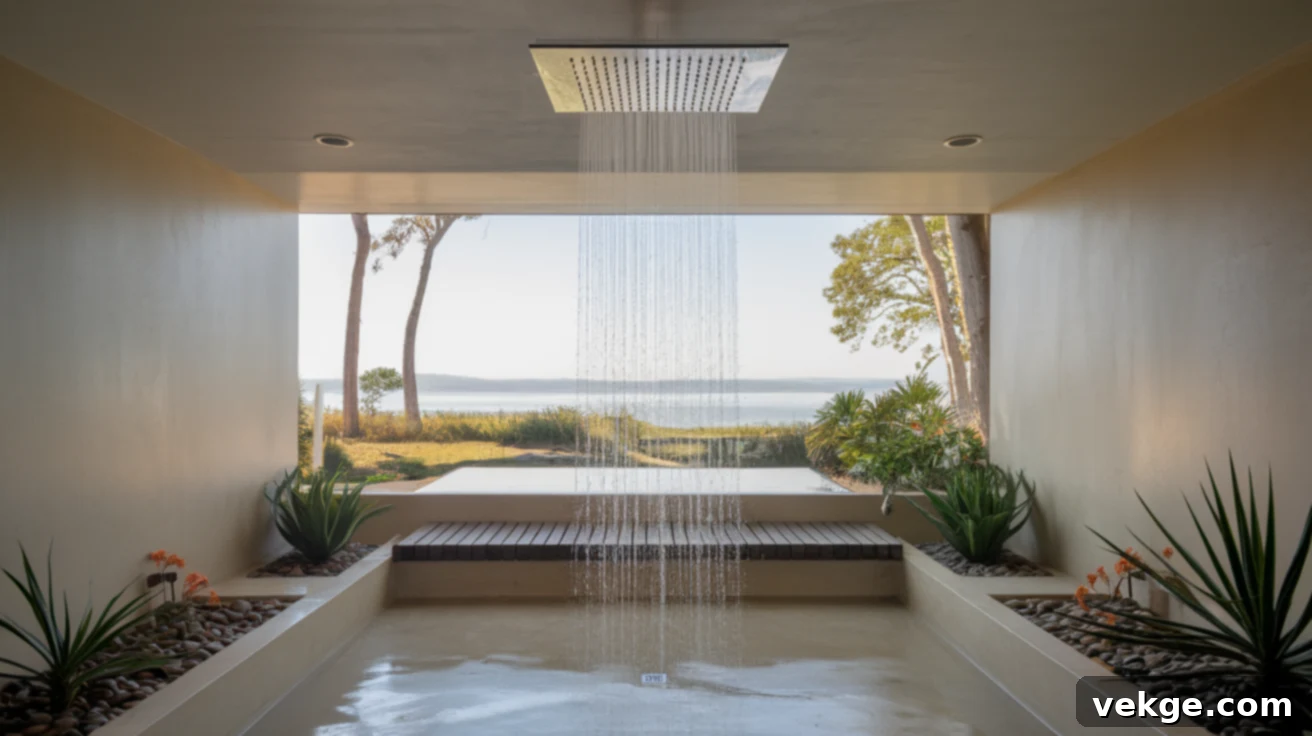
A ceiling-mounted showerhead is a superb choice for a small wet room, offering both practical and aesthetic advantages. By installing the showerhead directly into the ceiling, you eliminate bulky fixtures on the wall, instantly creating a cleaner, more minimalist, and less cluttered appearance. This design choice frees up valuable visual and physical wall space, contributing to a more open feel.
Beyond its space-saving qualities, a ceiling-mounted shower often delivers a luxurious rainfall effect, distributing water evenly over a wider area for a truly immersive and comfortable shower experience. The streamlined integration complements modern wet room designs beautifully, emphasizing clean lines and understated elegance. It’s an effective way to inject a touch of spa-like luxury without complicating the overall layout.
15. DIY Towel Racks and Hooks for Custom Storage
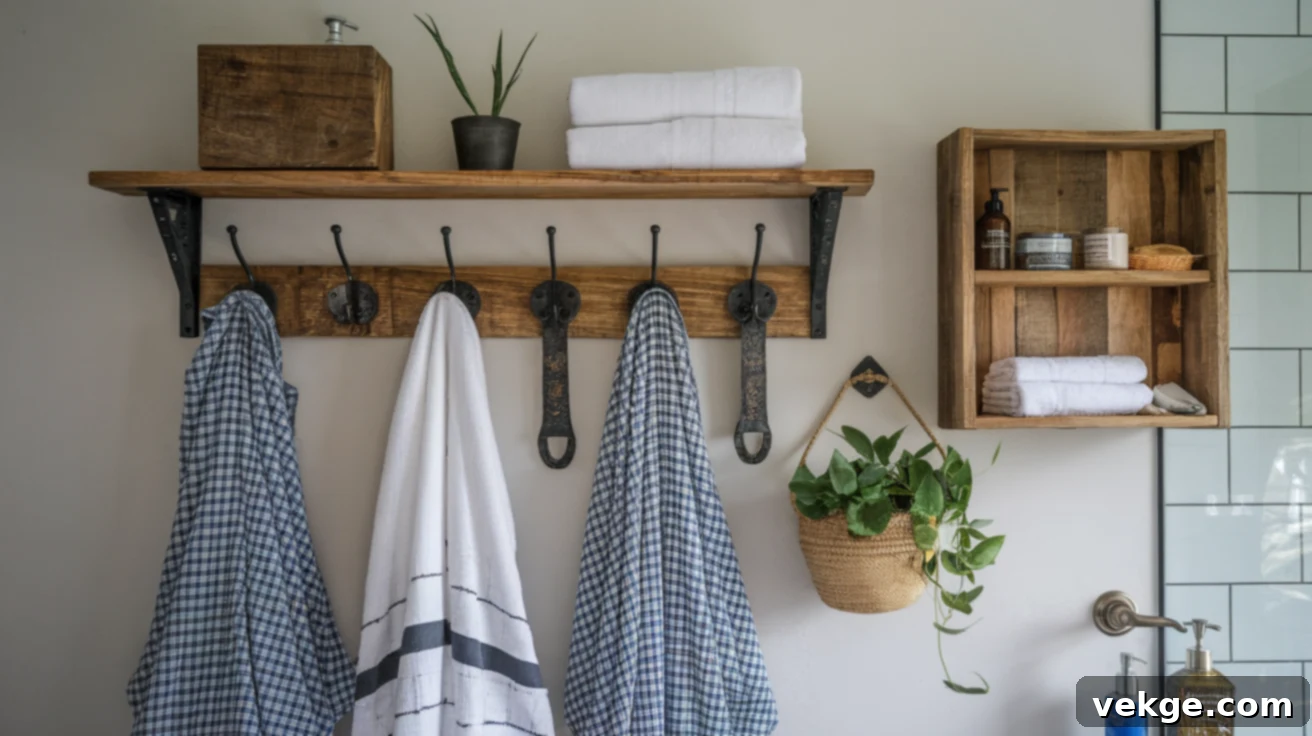
Why spend a fortune on expensive designer towel racks when you can create unique, personalized storage solutions through DIY? Repurposing materials like rustic wood planks, industrial-style pipes, or even stylish old cabinet handles can transform into functional and attractive towel racks or hooks. This approach not only keeps costs significantly low but also adds a distinctive touch of personality and charm to your wet room.
DIY racks and hooks provide practical storage for towels and bathrobes without requiring large investments. They can be customized to fit awkward spaces or specific design aesthetics, ensuring every inch is utilized efficiently. Embracing this creative route allows you to infuse your wet room with character and style, demonstrating that thoughtful design doesn’t always come with a hefty price tag.
16. Repurpose Old Furniture for Unique Storage

Give old furniture a new lease on life by repurposing it for storage in your wet room. An old dresser, a vintage cabinet, or even sturdy shelving units can be transformed into charming and functional storage solutions. With a fresh coat of waterproof paint or sealant, these pieces can withstand the humid environment of a wet room while providing ample space for toiletries, towels, and other bathroom essentials.
This eco-friendly and cost-saving approach adds incredible character and a unique, bespoke feel to your wet room that you wouldn’t get from off-the-shelf items. It reduces waste, saves money, and allows for a truly personalized design statement, helping to keep your wet room organized and distinctive.
17. Add a Small Built-In Niche for Convenience
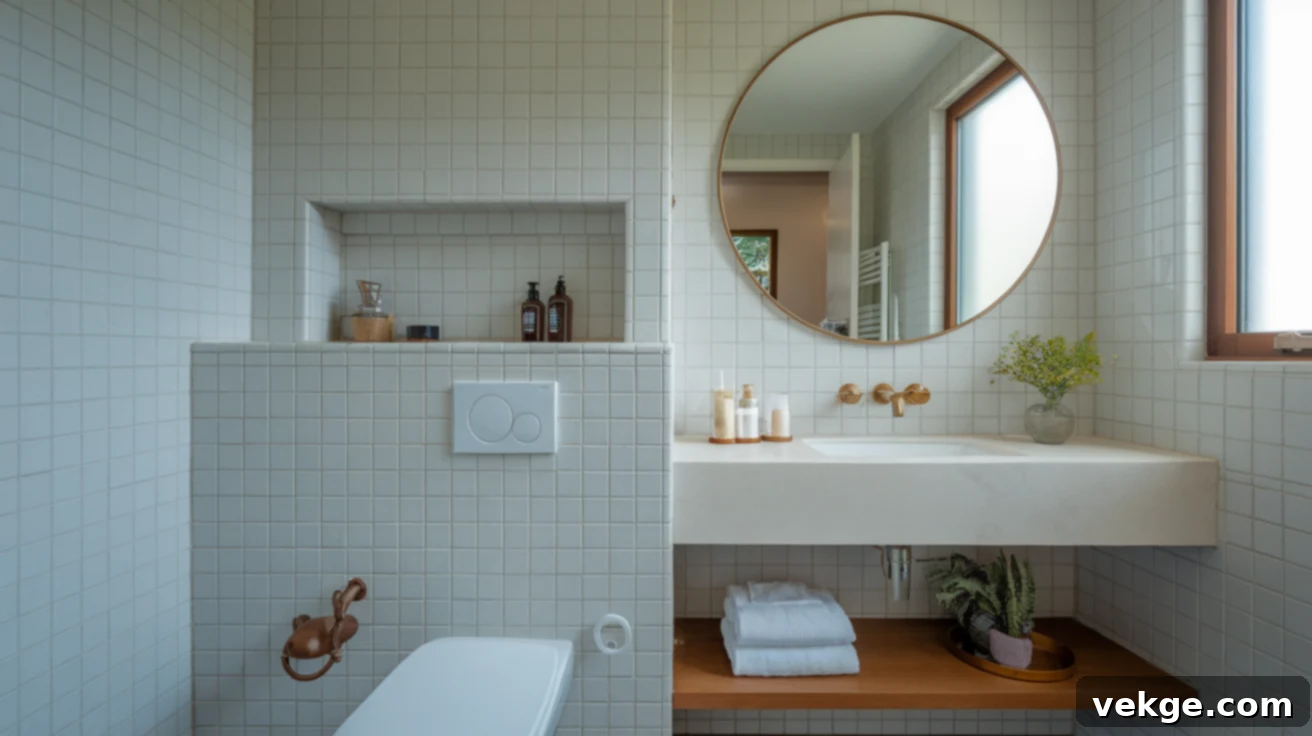
In a small wet room, every design element should serve a purpose and ideally save space. A built-in niche is an elegant and highly practical solution for recessed storage within the shower area. By utilizing the space within the wall cavity, you create a discreet shelving unit for shampoos, soaps, and other toiletries without adding any bulky, protruding shelves that can clutter a small space.
These integrated niches maintain a clean, minimalist look, contribute to the seamless design of a wet room, and keep all your essentials neatly organized and within easy reach. They are a clever, space-saving alternative to traditional shower caddies or shelves, enhancing both the functionality and aesthetic appeal of your compact wet room.
18. Use a Shower Curtain Instead of Glass Partitions
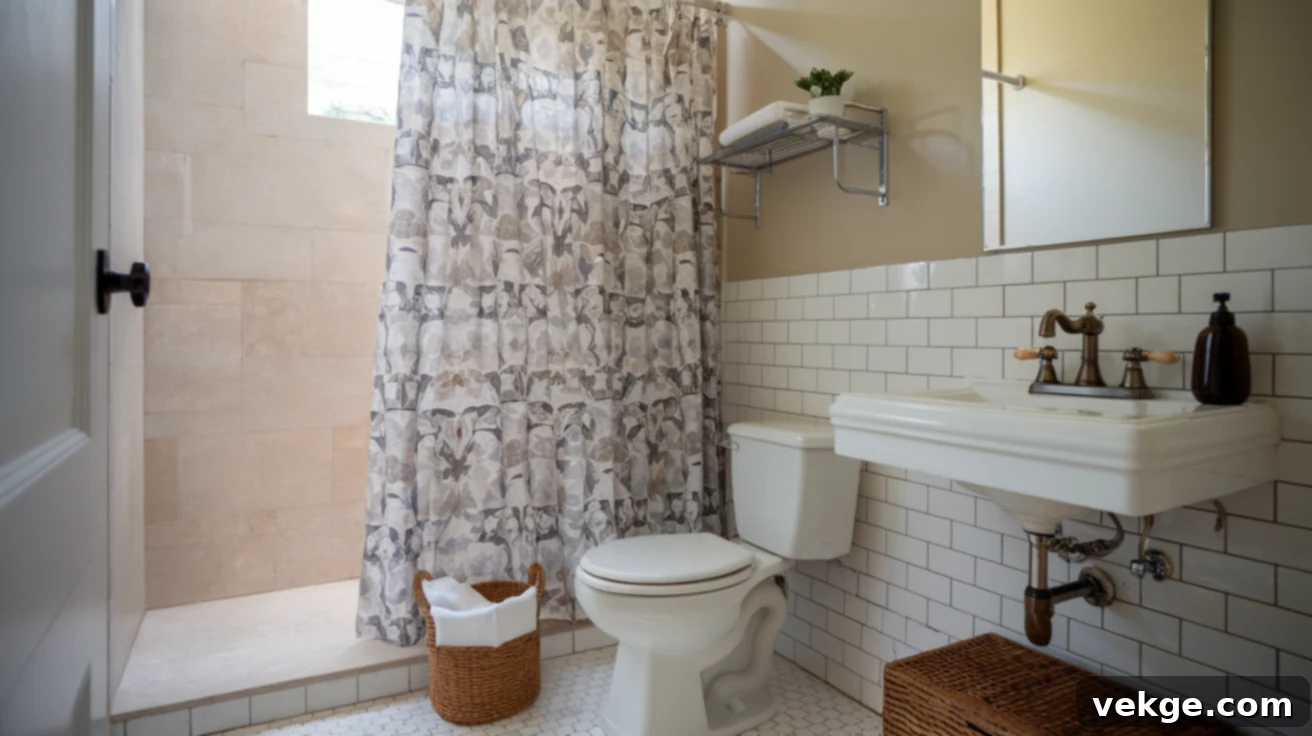
While glass screens offer a modern look, a shower curtain remains one of the most budget-friendly and versatile alternatives for containing water in a wet room. Shower curtains are incredibly easy to install, requiring minimal hardware, and they can be replaced quickly and affordably whenever you desire a change in style or color. This allows for effortless customization to match your evolving decor.
Unlike glass partitions, shower curtains don’t demand constant deep cleaning to maintain their sparkle and clarity. They can be easily washed or replaced, making maintenance a breeze. This flexible and cost-effective solution provides privacy and water containment while allowing you to update your wet room’s look with minimal financial commitment.
19. Install Energy-Efficient LED Strip Lighting
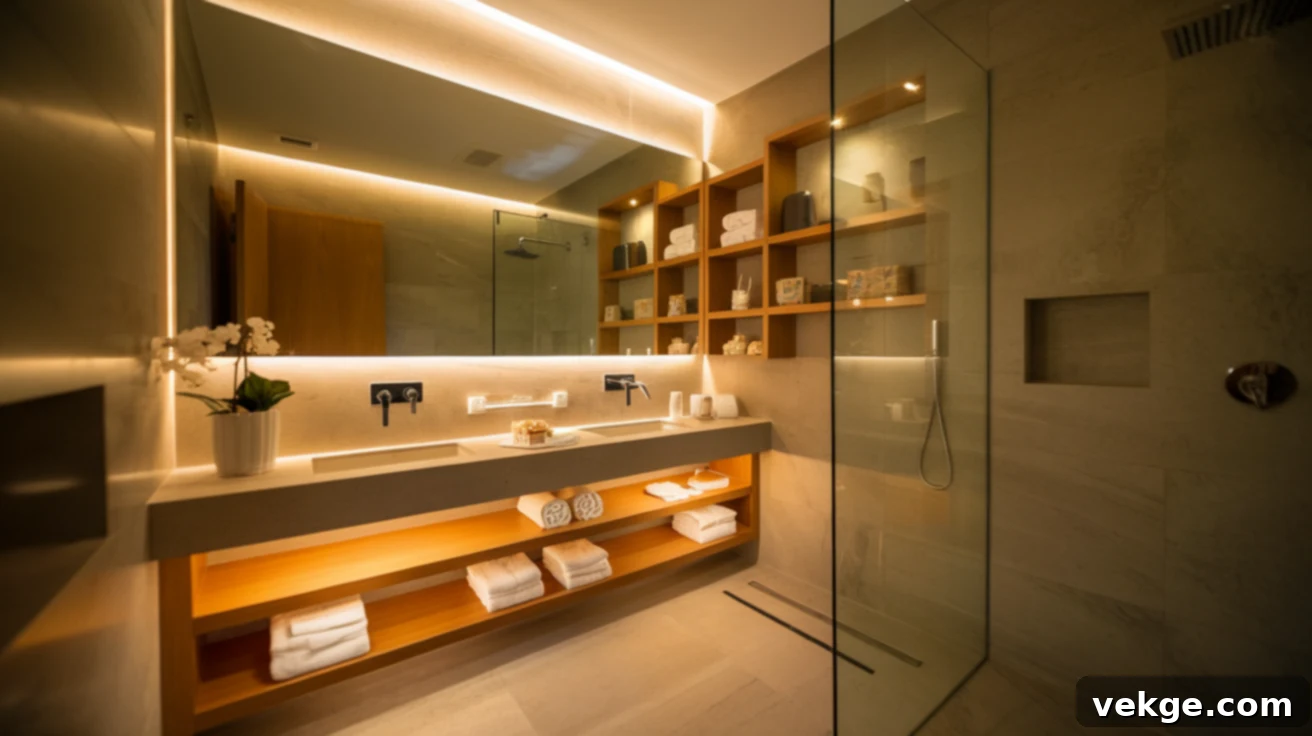
Lighting plays a crucial role in shaping the ambiance and perceived size of a small wet room. LED strip lights are an excellent choice for adding soft, energy-efficient illumination while creating a modern, sophisticated atmosphere. These versatile lights can be subtly integrated under floating cabinets, along the edges of mirrors, or around the ceiling perimeter, providing accent lighting without taking up any physical space.
LED strip lighting enhances the overall mood and aesthetic of the wet room, making it feel more luxurious and inviting. Furthermore, LED technology is highly energy-efficient, keeping electricity costs low while providing ample light. This customizable lighting option allows you to highlight architectural features or create specific moods, adding a contemporary touch that’s both functional and stylish.
20. Go for a Simple Rainfall Showerhead
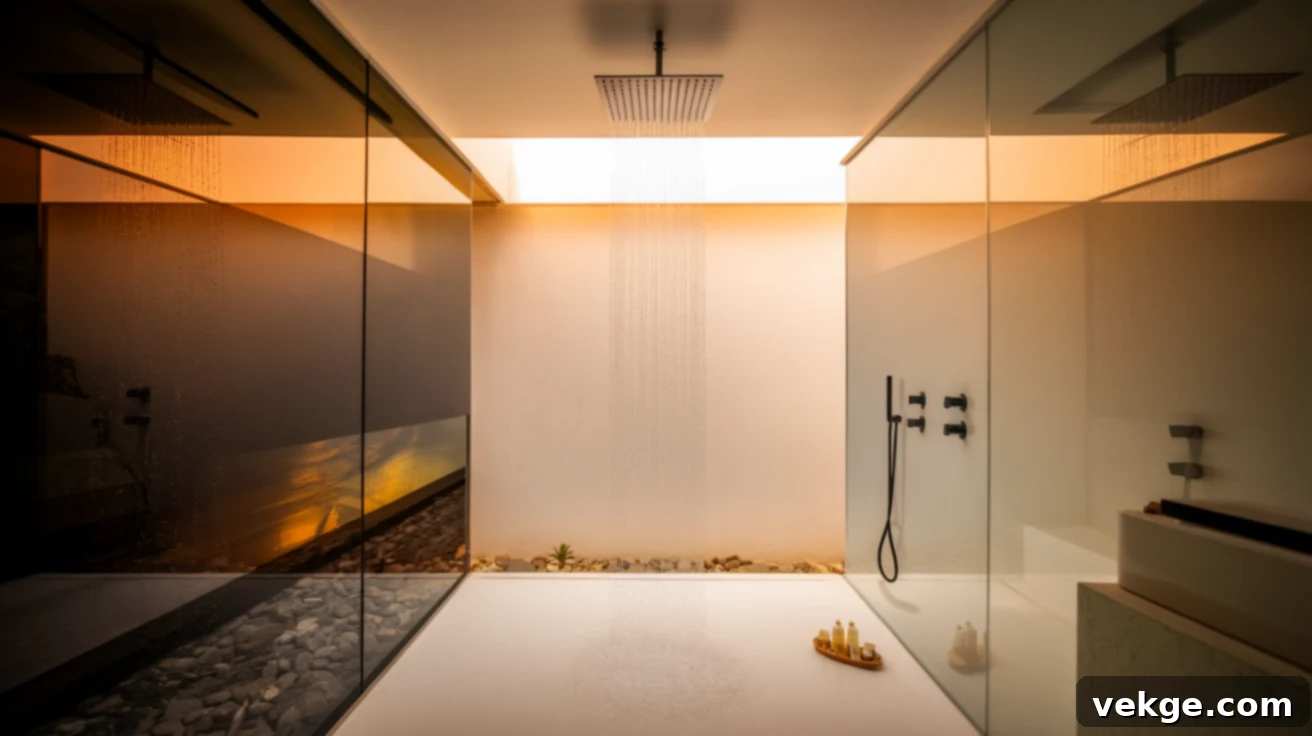
Achieving a spa-like experience in your wet room doesn’t require an extravagant budget. A simple rainfall showerhead, often available at very affordable prices, can provide an even, soothing water flow that mimics a luxurious downpour. This type of showerhead offers a wonderful showering experience with minimal installation effort compared to more complex multi-jet systems.
A rainfall showerhead adds an instant touch of modern luxury and elegance to any wet room without the need for major renovations or extensive plumbing work. It complements the minimalist aesthetic of a wet room beautifully, focusing on the simple pleasure of a powerful, enveloping spray. It’s a smart way to upgrade your daily routine and enhance your bathroom’s appeal on a modest budget.
21. Keep Plumbing Exposed for an Industrial Look
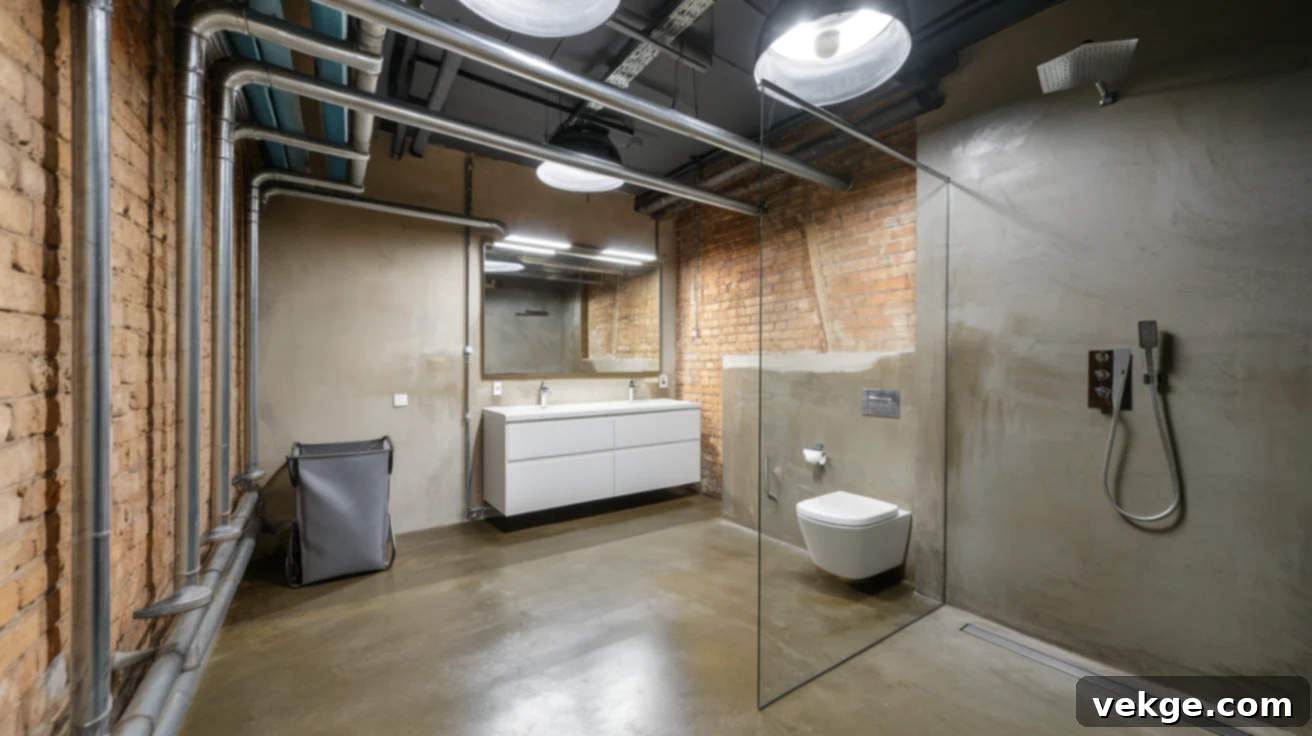
For a truly unique and budget-savvy approach, consider embracing the industrial-chic aesthetic by keeping your plumbing exposed. Rather than spending money on concealing pipes and fixtures behind walls, let them become a design feature. This trend adds a raw, urban, and highly contemporary vibe to your wet room, celebrating the functional elements of the space.
Beyond the trendy design, exposing plumbing saves significant money on renovation costs, as you eliminate the need for drywall, plastering, and tiling to hide pipes. It also simplifies future maintenance and repairs, as all components are easily accessible. This bold choice offers a distinctive, modern appeal while being inherently cost-saving and practical, making your wet room stand out.
Essential Tips for Creating a Wet Room in a Small Bathroom
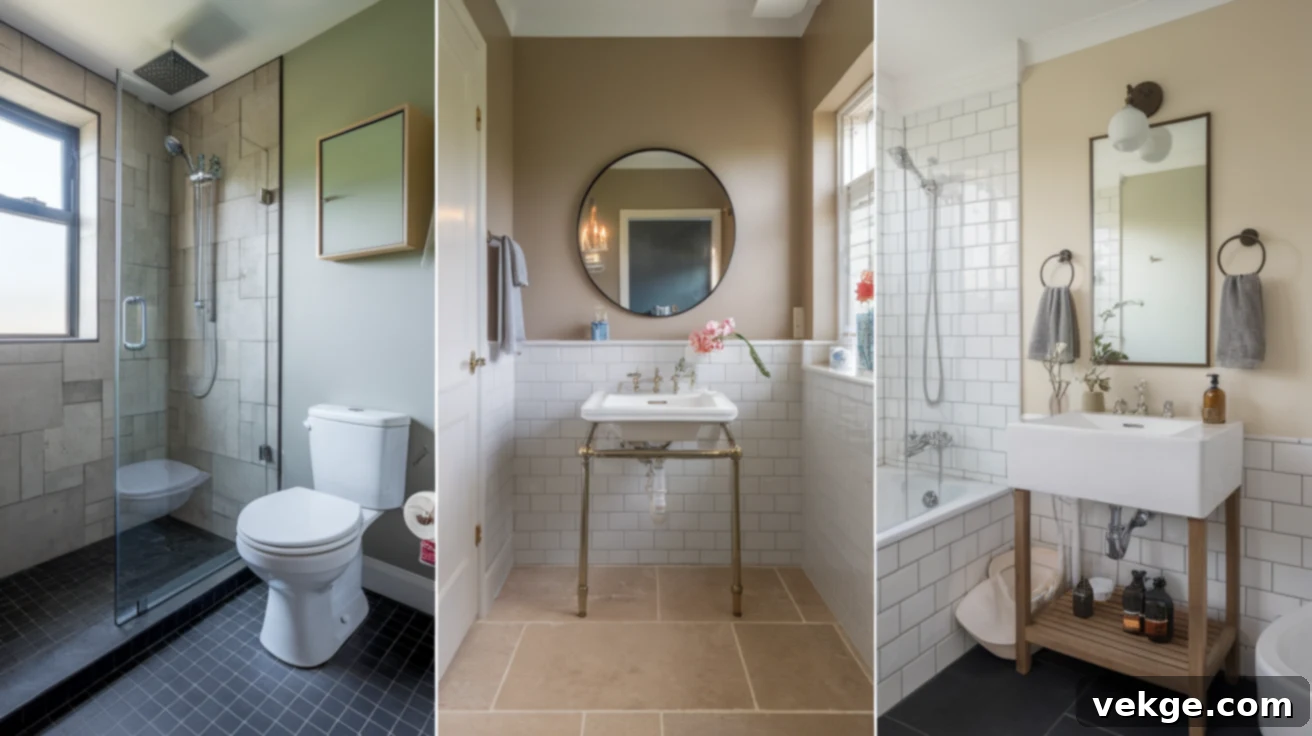
1. Plan Drainage with Precision
Proper drainage is the cornerstone of any successful wet room, especially in a small space. It’s crucial to focus on creating an adequate floor slope towards the drain. If the floor is too flat or the slope is insufficient, water will puddle in various areas, leading to potential slip hazards, mold growth, and even water damage to surrounding structures. Aim for a gentle yet effective incline that ensures all water efficiently flows directly into the drain, keeping your wet room consistently dry and hygienic after use. This meticulous planning prevents costly issues down the line and is paramount for both safety and longevity.
2. Invest in Quality Waterproofing (Non-Negotiable)
While sticking to a budget is important, there is one area where you absolutely should not cut corners: waterproofing. This critical step protects your walls, floors, and the underlying structure of your home from water penetration, mold, and rot. Investing in high-quality waterproofing materials and professional installation is worth every penny to prevent expensive and destructive repairs in the future. Think of it as the invisible shield that ensures your wet room remains a functional and safe space for years to come.
3. Maximize Vertical Space Cleverly
In a small wet room, thinking vertically is key to maximizing available space without sacrificing functionality or creating clutter. Utilize wall-mounted shelves, recessed niches, or sleek vertical cabinets. These solutions free up valuable floor area, making the room feel larger and more open. Keeping essentials organized and easily accessible on walls ensures your wet room remains streamlined, efficient, and visually expansive.
4. Prioritize Excellent Ventilation
Adequate ventilation is absolutely essential in a wet room to prevent the build-up of moisture, which can lead to mold, mildew, and stale odors. A powerful exhaust fan, properly sized for the room’s volume, is crucial. If possible, incorporate a window for natural airflow. Good ventilation keeps your wet room dry, fresh, and hygienic, protecting your investment and ensuring a comfortable environment.
5. Think About Accessibility and Comfort
Designing a wet room should always prioritize comfort and ease of use for everyone. Even in a tiny wet room, ensure there’s enough clear space for comfortable movement. This might involve careful placement of fixtures, opting for a handheld showerhead for flexibility, or installing grab bars if needed. A well-planned, accessible wet room enhances your daily routine and caters to future needs, ensuring it remains a functional and enjoyable space for years to come.
Mistakes to Avoid When Designing a Wet Room in a Small Space
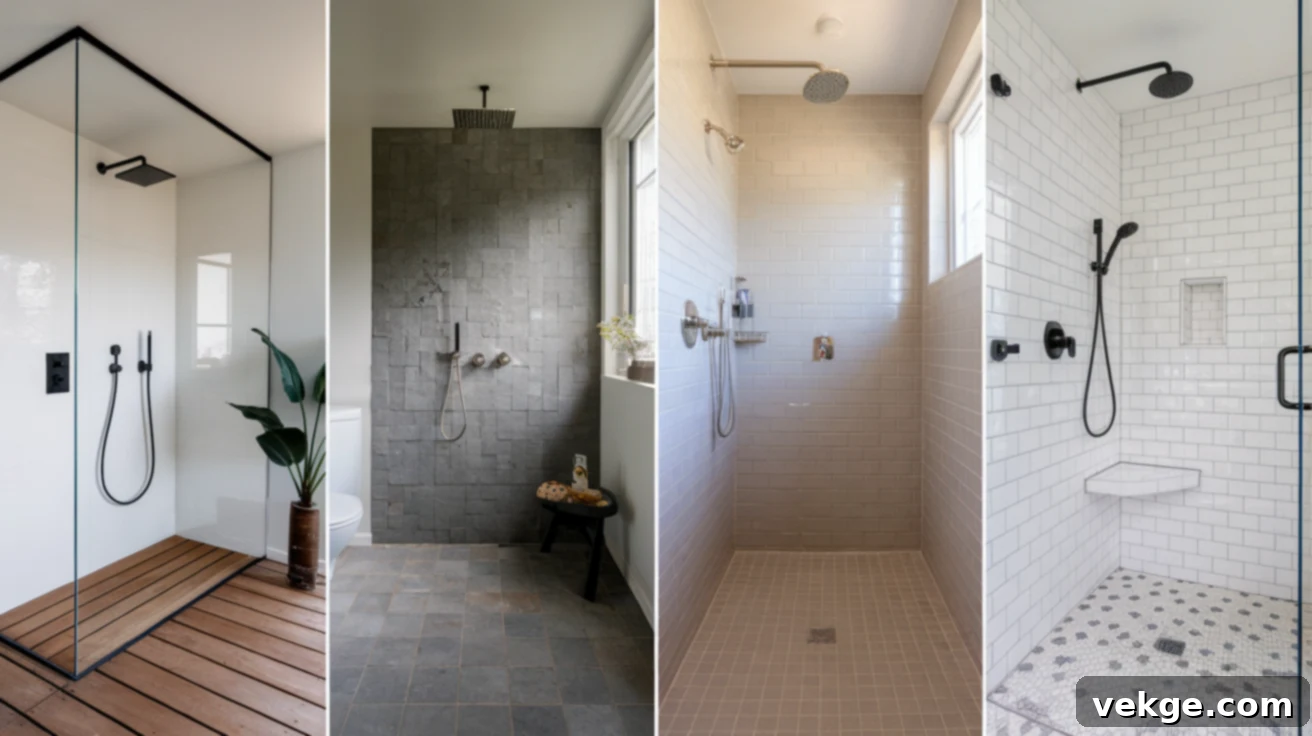
1. Skipping Essential Waterproofing
This cannot be emphasized enough: never skip or cut corners on waterproofing. A wet room, by definition, is designed to get wet, and without a robust, professional-grade waterproofing membrane beneath your tiles or wall panels, water will inevitably seep into cracks and porous surfaces. This leads to severe consequences such as mold growth, dampness in adjacent rooms, and significant structural damage to your home. The cost of rectifying such issues far outweighs the initial investment in proper waterproofing. Ensure all walls and floors in the wet area are thoroughly tanked and sealed to create an impenetrable barrier, forming the absolute foundation of a durable and problem-free wet room.
2. Poor Drainage Planning
One of the most common and frustrating mistakes is inadequate drainage planning. If your wet room floor is too flat or the slope towards the drain is insufficient, water will pool in undesirable spots. This creates slippery surfaces, increases the risk of falls, and can lead to water lingering for too long, potentially causing damage or fostering mold. A slight, consistent incline towards a well-placed drain is critical. Consult with an experienced installer to ensure the correct fall is achieved, guaranteeing efficient water removal and a safe environment.
3. Using the Wrong Flooring Materials
Choosing flooring that isn’t suitable for a wet room can lead to both safety hazards and maintenance nightmares. Highly polished or non-slip-rated tiles can become extremely dangerous when wet. It’s crucial to select slip-resistant materials such as textured ceramic, porcelain, or specialized vinyl flooring. These options provide necessary traction even when wet, significantly reducing the risk of accidents. Additionally, consider materials that are easy to clean and resist staining, ensuring your wet room remains both safe and aesthetically pleasing over time.
4. Ignoring Practical Storage Needs
While a minimalist aesthetic is desirable in a small wet room, completely ignoring storage needs can quickly lead to clutter and frustration. A wet room without designated storage for toiletries, towels, and cleaning supplies will feel disorganized and cramped, detracting from its appeal. Incorporate smart, space-saving storage solutions like built-in niches within the shower, wall-mounted shelves, or floating vanity units. Planning for essential storage from the outset ensures everything has its place, keeping your wet room tidy, functional, and visually appealing.
5. Overcrowding the Space with Fixtures
In an attempt to include every desired feature, homeowners sometimes overcrowd a small wet room with too many fixtures, leaving little room to move comfortably. This can make the space feel claustrophobic and impede functionality. Embrace the “less is more” philosophy. Choose essential fixtures that are proportionate to the room’s size and ideally serve multiple purposes, like a vanity with integrated storage. A simple, well-thought-out layout with clear pathways will make your small wet room feel significantly larger, more inviting, and ultimately more practical. Trust me, you’ll appreciate the breathing room.
Conclusion
Embarking on a wet room transformation for your small bathroom doesn’t have to be a daunting or expensive endeavor. As this extensive list of 21 budget-friendly ideas demonstrates, with thoughtful planning, clever material choices, and a dash of creativity, you can achieve a truly functional and stylish space without draining your savings.
Remember, the key lies in maximizing visual space, prioritizing functionality, and ensuring durable, waterproof solutions. Whether you opt for large format tiles to minimize grout, choose affordable wall panels, or integrate space-saving fixtures like a wall-mounted sink or floating toilet, each decision contributes to a more open, modern, and easy-to-maintain wet room.
Even small changes can yield significant results. Consider starting with one or two ideas that resonate most with your vision and budget. Perhaps it’s swapping traditional tiles for waterproof paint, installing a simple frameless shower screen, or upgrading to a minimalist showerhead. The journey to your ideal wet room can be incremental and enjoyable.
You absolutely can create a stunning wet room without breaking the bank. The impact of smart updates on a small space is remarkable. Which of these innovative, budget-friendly ideas will you implement first to transform your small bathroom into a captivating wet room?
Frequently Asked Questions
Are Wet Rooms Harder To Heat?
Wet rooms are generally not harder to heat than standard bathrooms. They can be heated very effectively using modern solutions like underfloor heating or appropriately-sized wall-mounted heaters. Proper insulation and good ventilation are key to trapping warmth and preventing excessive moisture build-up, ensuring the space remains comfortable and efficiently heated.
Can A Wet Room Increase My Home’s Value?
Yes, a well-designed and professionally installed wet room can indeed increase your home’s value, especially if it adds an additional bathroom or updates an existing outdated one. Modern features and improved accessibility, which wet rooms often offer, are highly appealing to potential buyers. However, the final impact depends heavily on factors like overall market trends, the quality of the installation, and how well it integrates with the rest of your home’s style.
Can I Use Electric Heating In My Wet Room?
Absolutely, electric heating options such as underfloor heating systems or electric towel rails are safe and commonly used in wet rooms. However, it is paramount that all electric installations are carried out by a qualified professional electrician. They must ensure that all components meet the specific IP (Ingress Protection) ratings required for wet areas and comply with local safety standards and building regulations to prevent any hazards.
Do I Need Special Lighting For A Wet Room?
Yes, it’s essential to use special lighting fixtures rated for wet areas (indicated by an IP rating, e.g., IP44 or higher for zones close to the shower). These fixtures are designed to be moisture-resistant and safe in high-humidity environments. Proper lighting not only improves visibility and enhances the aesthetic but also ensures safety. Always consult an electrician to select and install appropriate lighting that complies with all safety regulations.
How Often Should I Clean A Wet Room?
For optimal hygiene and to maintain its pristine appearance, a thorough cleaning of your wet room is recommended at least once a week. Pay special attention to drains, grout lines (if applicable), and corners where moisture might linger. Additionally, a quick wipe-down of surfaces and a squeegee on glass screens after each shower can significantly help prevent soap scum and mold buildup, making weekly deep cleans much easier.
